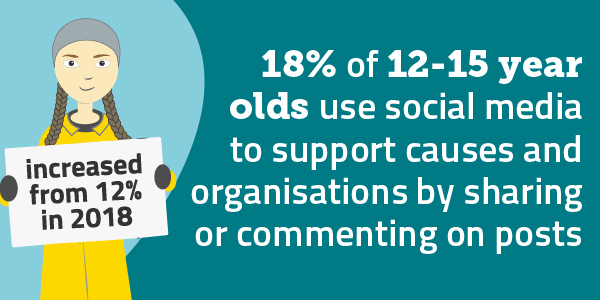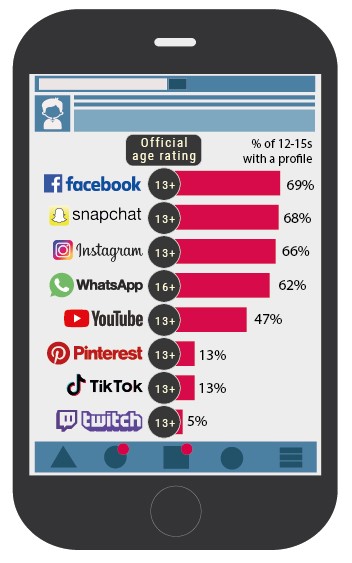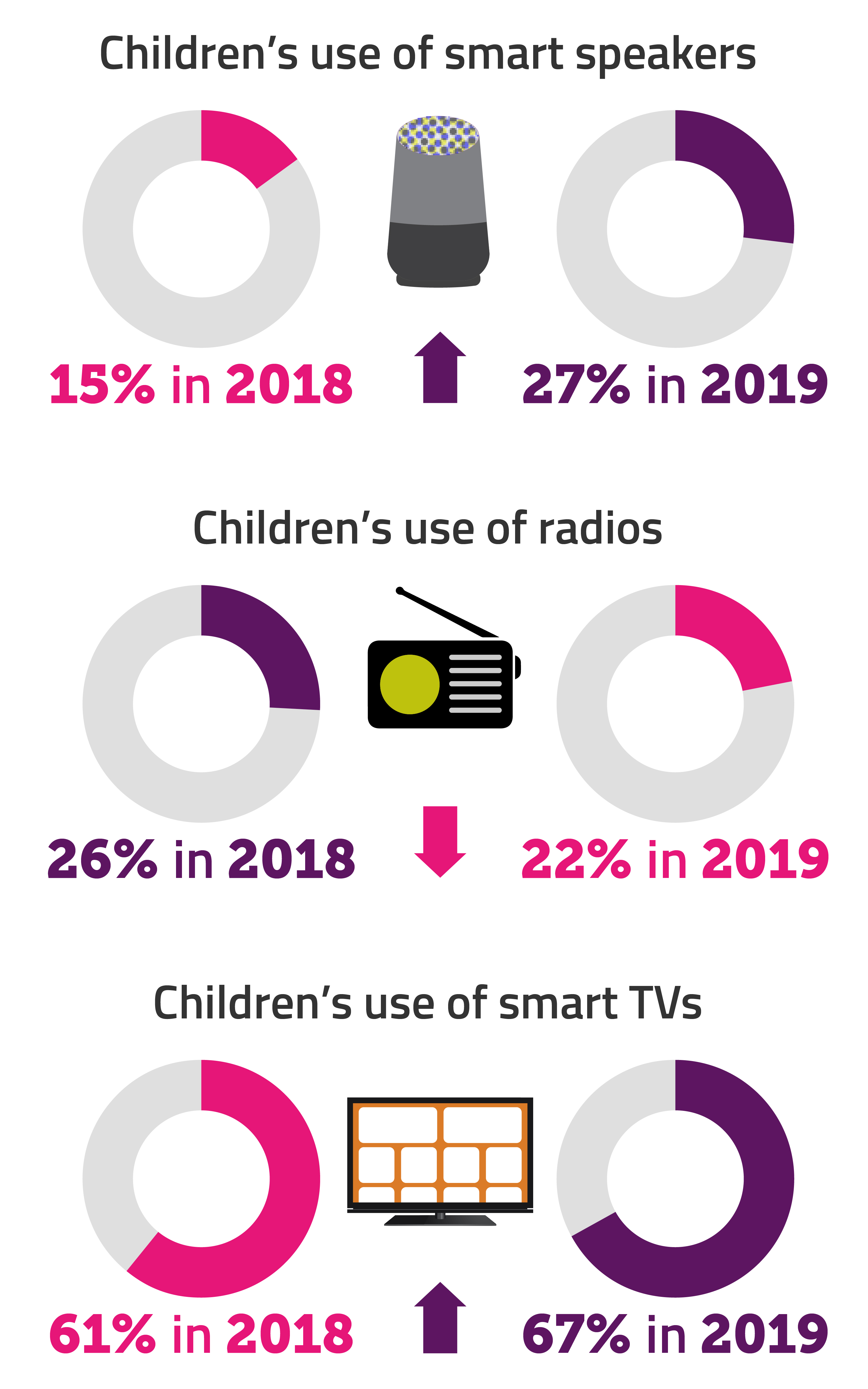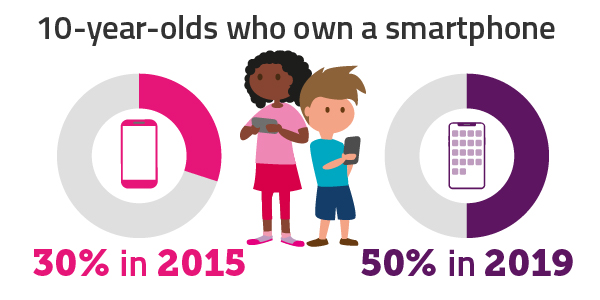- Gaming and self-harm among biggest concerns
- Half of older children have seen hateful content online
- 'Greta effect' driving increased online social consciousness among kids
More parents than ever feel children’s online use now carries more risks than benefits, according to Ofcom’s latest annual study of children’s media and online lives.
Parents and carers are becoming more likely to trust their children with greater digital independence at a younger age[2]. But far fewer believe the benefits of their child being online outweigh the risks than five years ago (55%, down from 65% in 2015). And around two million parents now feel the internet does their children more harm than good.
This comes as children are now more likely to see hateful content online. Half (51%) of 12-15s who go online had seen hateful content in the last year, an increase from 34% in 2016.[3]
Parents are increasingly concerned about their child seeing content which might encourage them to harm themselves (45%, up from 39% in 2018). Similarly, two gaming-related problems are increasingly concerning parents: the pressure on their child to make in-game purchases of things like ‘loot boxes’, a virtual item containing rewards (47%, up from 40%); and the possibility of their child being bullied via online games (39%, up from 32%).
However, parents are now more likely than in 2018 to speak to their children about staying safe online (85%, up from 81%). They are also nearly twice as likely to go online themselves for support and information about keeping their children safe than a year before (21%, up from 12%).
Influencers, online activism and girl gamers
Looking at what today’s children are doing online, Ofcom has uncovered three notable online trends over the last year.
 The 'Greta effect'. We have seen an increase in online social activism among children. Almost a fifth (18%, up from 12% in a year) of 12-15s use social media to express support for causes and organisations – potentially environmental, political or charitable – by sharing or commenting on posts. One in 10 signed petitions on social media.
The 'Greta effect'. We have seen an increase in online social activism among children. Almost a fifth (18%, up from 12% in a year) of 12-15s use social media to express support for causes and organisations – potentially environmental, political or charitable – by sharing or commenting on posts. One in 10 signed petitions on social media.- Rise of the ‘vlogger next door’. While high-profile YouTube stars remain popular, children are now increasingly drawn to influencers like them. These people, known as ‘micro’ or ‘nano’ influencers, often have fewer followers. They might be local to a child’s area or share a niche interest. Children described these influencers as more relatable and directly engaged with their followers, while others described being able to imitate their content on their own social media channels.
- Girl gamers on the increase. Almost half (48%) of girls aged 5-15 now play games online – a big rise from 39% in 2018. The proportion of boy gamers is unchanged at 71%, but boys spend twice as long playing online each week as girls (14 hours 36 minutes vs. 7 hours 30 minutes). Boys cited FIFA, Crew 2, Destiny 2 and Fortnite as examples of the games they play.
Social media use more fragmented

Today’s study finds that older children are using a wider range of social media platforms than ever before. WhatsApp in particular has grown in popularity among 12-15 year-olds since last year, despite having a minimum age limit of 16.
WhatsApp is now used by almost two thirds of older children (62%) – up from 43% in 2018. For the first time, it rivals Facebook (69%), Snapchat (68%) and Instagram (66%) as one of the top social media platforms for older children.
Newer platforms such as TikTok – which enables users to create 15-second lip-sync, comedy and talent videos – are also becoming more popular. Around one in seven older children use TikTok (13%) – up from 8% in 2018. One in 20 older children use Twitch – the live streaming platform for gamers.
Alexa – how many children use smart speakers?
Children are using more connected devices than ever before. Among these, smart speakers saw the biggest increase in use over the last year. More than a quarter of children now use them – up from 15% in 2018 – overtaking radios (22%) for the first time. Children’s use of smart TVs also rose from 61% to 67%.
Children’s viewing habits are changing radically too. Almost twice as many children watch streaming content than they did five years ago (80% in 2019 vs. 44% in 2015). In 2019, fewer children watched traditional broadcast TV than streaming content (74%), with a quarter not watching it at all.
But YouTube is as popular as ever, remaining children’s firm favourite for video ahead of Netflix, Amazon Prime, the BBC and ITV.[4]
The age of digital independence
 When it comes to going online, children are most likely to use a tablet (68%) but mobiles are becoming increasingly popular and children are now as likely to use a mobile as they are laptops (55%).[5]
When it comes to going online, children are most likely to use a tablet (68%) but mobiles are becoming increasingly popular and children are now as likely to use a mobile as they are laptops (55%).[5]
This move to mobile is being driven by older children, for whom 10 is becoming the age of digital independence. Between age nine and 10, the proportion of children who own a smartphone doubles from 23% to 50% – giving them greater digital autonomy as they prepare to move to secondary school. By the time they are 15, almost all (94%) children have one.[6]
Yih-Choung Teh, Strategy and Research Group Director at Ofcom, said: “Today’s children have never known life without the internet, but two million parents now feel the internet causes them more harm than good.
“So it’s encouraging that parents, carers and teachers are now having more conversations than ever before with children about online safety. Education and stronger regulation will also help children to embrace their digital independence, while protecting them from the risks.”
Email Newsletters
Sign up to receive TelecomTV's top news and videos, plus exclusive subscriber-only content direct to your inbox.



